Iloca
The Iloca Camera Werk was originally founded by A. Walter Illing in about 1947 as a small precision mechanical workshop in Hamburg, Germany.[1] A first camera was supposed to be named Ilca, but this was too close to ICA and therefore was changed to Iloca (styled "Jloca"). In 1950 Wilhelm Witt took over and led the company into a very successful decade of steep ascent, both technically and commercially. Early models were the Iloca I, Ia, II and IIa, which were small and relatively simple viewfinder and rangefinder cameras. The "Quick" series introduced automatic cocking of the shutter when winding the film. The name "Rapid" came from the adoption of a rapid winding lever. The cameras were sold very successful in the 1950s through the Sears mail order catalogue in the USA. However, the company was probably best known for their range of stereo cameras.
Their main claim to fame was the introduction of the Iloca Electric in 1959, the first 35mm camera with an integrated electric motor wind. It was rather expensive in Europe and was quite successful in the USA where it was sold as the Graphic 35 Electric. The next camera was supposed to be the auto-electric, basically the same body including the electric motor drive, but a fixed lens. It's main claim would have been a trap needle auto-exposure feature. However, F. Deckel did not supply the ordered Compur-automat shutters and with this forced Iloca into bankruptcy, which was filed in early April 1960. Witt accused Deckel and its parent company Carl Zeiss for exploiting a dominant market position, ultimately too late for the company.[2] 200 employees were sent home and the company stopped existing. The remaining assets including the readily developed auto-electric were sold to Agfa, who launched this camera as the Agfa Selecta m - with a fixed f2.8 Solinar lens.
Iloca cameras
| ||
|
- Iloca I and Ia
- Iloca II
- Iloca IIa
- Iloca Quick (including Quick-A, Quick L, and Quick R)
- Iloca Quick B and Photrix Quick-B (rangefinder focus)
- Iloca Rapid and Rapid A1 - 1952
- Iloca Rapid B / Sears Tower 51 - 1954
- Iloca Rapid - 1956
- Iloca Rapid IL / MPP Iloca - 1956
- Iloca Rapid II / Iloca Rapid IIL / Sears Tower 52 / Argus V-100 - 1956
- Iloca Rapid IIR and III - 1959
- Iloca Stereo
- Iloca Stereo II / Photrix Stereo
- Iloca Stereo IIa / Tower 83
- Iloca Stereo Rapid / Realist 45
- Iloca Automatic
- Iloca Electric / Graphic 35 Electric - 1959
Notes
- ↑ Hartmut Thiele, Die Deutsche Photoindustrie - Wer war Wer, 8th edition, Munich 2021.
- ↑ "Die Verschlüsse kamen nicht..." historic newspaper article on Zeit.de (in German)
Links
- Iloca Camera pages at CJ's Classic Camera Collection
- Iloca Electric and company history at KniPPsen
- Iloca Rapid at Tigin's Classic Cameras (archived)
- Repair notes of the Iloca Rapid (A), Iloca Rapid B and Iloca IIa at Daniel Mitchell's camera site
- Witt page at Collection G. Even's site (in French)
- Iloca Realist instruction manual in PDF format (English) from OrphanCameras.com
- Iloca Quick A instruction manual in PDF format (English) from OrphanCameras.com
- Iloca Rapid I - IL - IIL instruction manual in PDF format (English) from OrphanCameras.com
- Iloca stereo II instruction manual in PDF format (English) from OrphanCameras.com
- Iloca Rapid a instruction manual from OrphanCameras.com
- Iloca Stereo II instructions from OrphanCameras.com
- Iloca Stereo Rapid instructions from OrphanCameras.com

